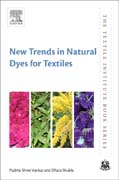
New Trends in Natural Dyes for Textiles addresses 20 natural dyes that are finding innovative uses in industry and academia. It comprehensively addresses issues relating to natural dyes and dyeing problems, including efficient extraction and standardization of dyes, dyes structure, dyes characterization and identification. Readers working in the dyeing of textiles will learn how to improve practices to minimize environmental pollution, avoid bad dyeing, and select the best mordants to fix colorant compounds. Key benefits of natural dyes over synthetic are examined in detail, providing readers with an understanding of the importance of natural dyes and the proper methods for applying them. Provides suitable extraction processes for each of the 20 dyes describedOffers complete and practical coverage of the whole dyeing process, from source selection to post-treatmentsCovers practical advice on the application of these dyes to cotton, silk and wool INDICE: Part A: Description of the newer natural dye sources 1. Allium cepa skin2. Althaea rosea flowers3. Artocarpus heterophyllus bark4. Bischofia javanica leaves5. Bougainvillea spectabilis flower6. Caesalpinia Sappan wood7. Camellia sinensis leaves8. Cassia fistula bark9. Cosmos sulphureus flower10. Eclipta alba leaves11. Eucalyptus globules bark12. Garcinia mangostana pericarp13. Gomphrena globosa flowers14. Hibiscus mutabilis flowers15. Impatiens balsamina flowers16. Ixora coccinea flowers17. Lawsonia inermis leaves18. Mahonia napaulensis stem19. Mirabilis jalpa flowers20.Tectona grandis leaves Part B: Isolation, and characterization of the colorant molecules from each dye plantPart C: Structure- mordant interactions Part D: Dyeing application of each dye on Cotton, Silk and Wool with fastness properties, CIELab values and shade card
- ISBN: 978-0-08-102686-1
- Editorial: Woodhead Publishing
- Encuadernacion: Rústica
- Páginas: 278
- Fecha Publicación: 14/12/2018
- Nº Volúmenes: 1
- Idioma: Inglés
